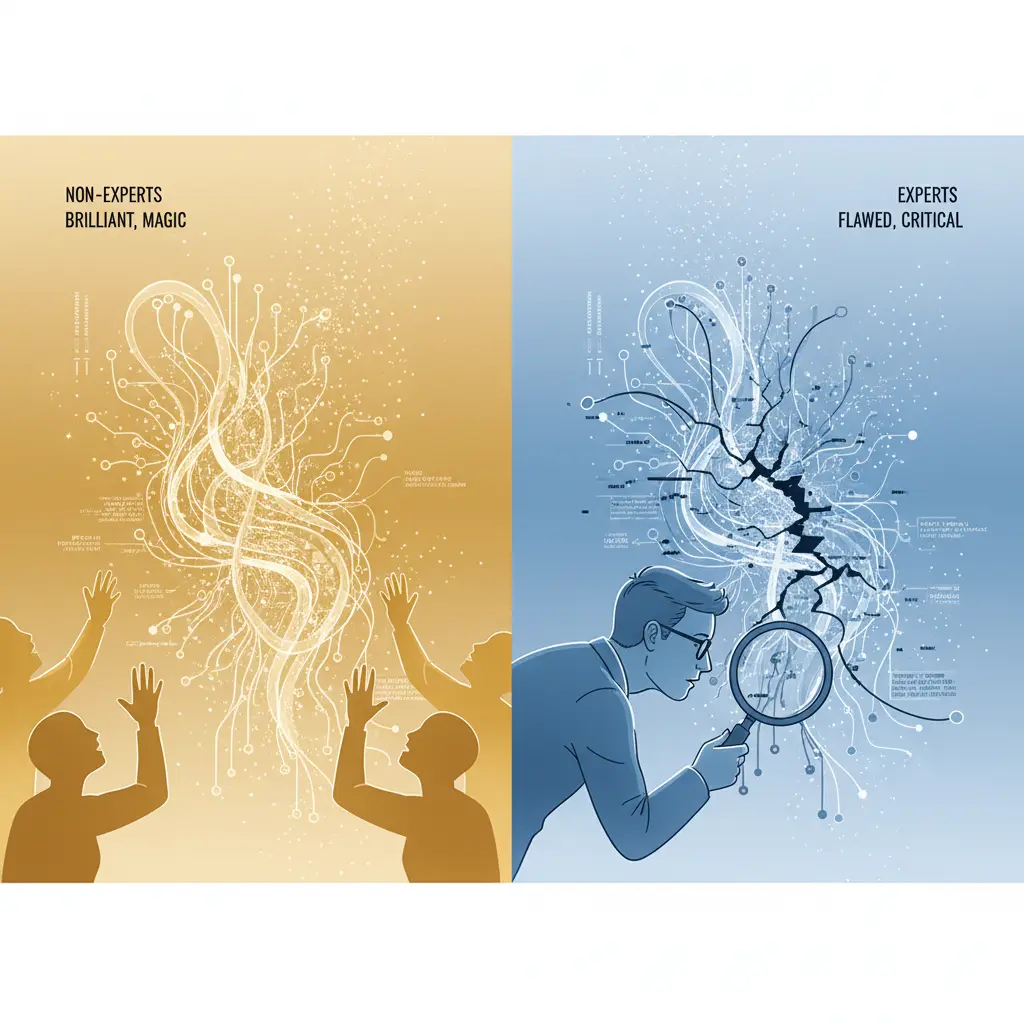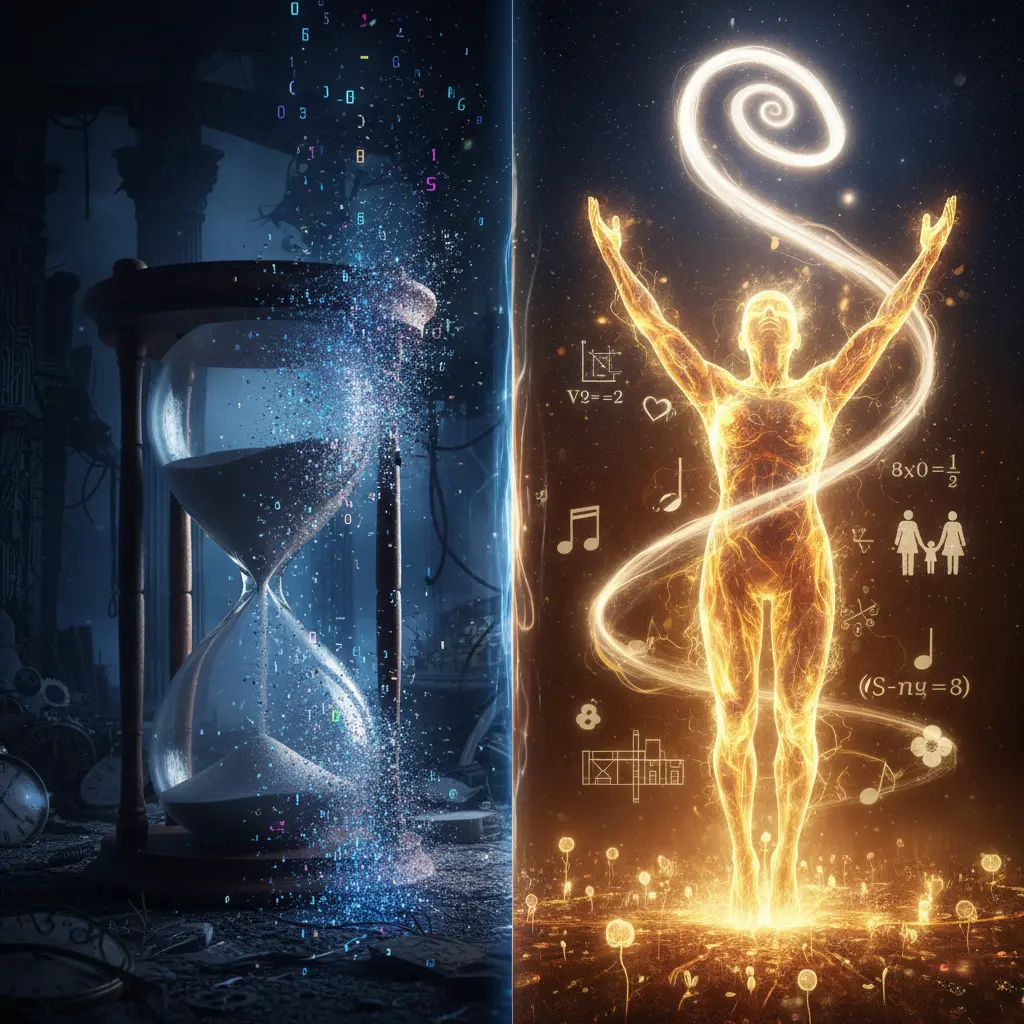The AI Illusion: Why It Seems Brilliant Until You Actually Know What You're Talking About
AI appears brilliant until you test it against real expertise. Discover why domain knowledge reveals AI's limitations and where the true opportunity lies.

The AI Illusion: Why It Seems Brilliant Until You Actually Know What You're Talking About
There's a fascinating phenomenon occurring across industries: AI appears magical and brilliant—until you apply it to something you genuinely understand. Not surface-level familiarity, but deep, hard-won expertise. The kind where you can spot mistakes others miss and know what excellence actually looks like.
That's when the illusion shatters.
And here's the critical insight: this isn't a problem to be solved. It's the entire opportunity.
Table of Contents
- The Inverse Correlation Nobody Talks About
- What Domain Experts See That Others Miss
- Where Current AI Actually Falls Short
- The Opportunity Isn't in Models—It's in Building With Them
- The Winning Formula: Expert + Technologist + Builder
- Why Augmentation Isn't Enough
- The Critical Gap Nobody's Filling
- What This Means for You
- The Opportunity Is Now
The Inverse Correlation Nobody Talks About
There's a pattern hiding in plain sight across AI implementations: the less you know about a domain, the more impressive AI appears when working in it.
This isn't speculation or anecdotal observation. It's backed by rigorous research across multiple fields.
In peer-to-peer lending studies, participants with domain knowledge made significantly fewer risky investments when using AI—4.1 on average compared to 5.7 for those without expertise (Dikmen & Burns, 2022). The experts didn't trust the AI more. They trusted it less. Because they could see where it was wrong.
In clinical settings, less experienced physicians followed erroneous AI advice. More experienced ones didn't (Micocci et al., 2021). The junior doctors thought the AI was brilliant. The senior consultants saw the cracks immediately.
Then there's the prostate cancer diagnosis study that really drives this home:
- AI alone: 0.730 accuracy
- Human experts: 0.674 accuracy
- Human+AI teams: 0.701 accuracy
The combination underperformed the AI working solo (Chen et al., 2025).
Why? Because expert radiologists were reluctant to trust the AI. Even when it was right. They knew too much about what could go wrong.
What Domain Experts See That Others Miss
When you give non-experts even basic domain knowledge, their relationship with AI changes completely. They demonstrate "less trust in AI and less reliance when the AI is incorrect" (Dikmen & Burns, 2022).
Knowledge creates skepticism. Not because the AI is useless, but because you can finally see its boundaries.
Three Critical Gaps Experts Identify:
1. Lack of Genuine Contextual Understanding
AI doesn't grasp "the intricacies of legal operations and nuances" in law (Kim et al., 2025). It can't replicate "the subtle understanding of complex scientific content that human expertise provides" in research (Doskaliuk et al., 2025). It misses the connective tissue that makes domain work actually work.
2. Inability to Assess Novelty or Significance Properly
In engineering education, AI evaluations were "more positive and holistic" whilst experts provided "more detailed and critical feedback" identifying specific deficiencies (Müller et al., 2025). The AI was basically too nice. Too uncritical. It couldn't tell the difference between good enough and genuinely excellent.
3. Overly Optimistic Assessments
When ChatGPT generated academic content, only 8% of its references were verifiable (Khlaif et al., 2023). It confidently cited sources that didn't exist. Non-experts wouldn't check. Experts would.
This is the gap. The space between appearance and reality.
Where Current AI Actually Falls Short
Let's be direct about AI's limitations. Not to diminish it, but to understand where the opportunity lives.
AI cannot fully replicate "depth of expertise, intuition, and critical thinking" (Doskaliuk et al., 2025). It lacks "the essential capability of creative thinking, which is crucial for problem-solving" (Chen et al., 2020). In legal applications, it struggles with "accurately embodying complex legal rules and reasoning" because law is "a flexible and evolving construct, subject to varied interpretations" (Kim et al., 2025).
These aren't small problems. They're fundamental.
But here's what matters: these limitations don't mean AI is useless. They mean we're building with it wrong.
We're treating AI like a magic solution you can drop into existing workflows. It's not. It's a component that needs expert integration.
The Opportunity Isn't in Models—It's in Building With Them
Every successful AI implementation has one thing in common: deep domain expertise baked into the system from day one.
Not bolted on afterwards. Not consulted occasionally. Embedded.
Real-World Evidence:
Mayo Clinic's AI Partnership
Succeeded through "integration of clinical, operational, and financial data, facilitating a holistic view" (Miller et al., 2024). That required clinicians who understood what mattered. What connected. What would actually work in practice.
Ford's Predictive Maintenance
Achieved real energy savings specifically because "engineering knowledge about machinery operations and failure modes" was embedded in the AI models (Miller et al., 2024). Engineers didn't just use the AI. They taught it how their world actually worked.
Materials Science Applications
Embedding domain knowledge enabled "significant reduction in data requirements for training ML models" (Miller et al., 2024). The experts made the AI more efficient by constraining it with reality.
This is the pattern: "domain knowledge is not just an add-on but a fundamental component in the responsible and ethical development and deployment of AI/ML solutions" (Miller et al., 2024).
The opportunity isn't in better models. It's in expert-led integration.
The Winning Formula: Expert + Technologist + Builder
Successful AI applications require three things working together:
Domain Expertise
Knowing what good looks like, what matters, what's actually difficult.
Technical Capability
Understanding what AI can and cannot do, how to build systems that work.
Builder Mindset
The willingness to reimagine processes from scratch rather than just augmenting what exists.
The research is clear: "close collaboration between legal professionals possessing domain knowledge and developers with technical expertise" is essential (Kim et al., 2025). Not occasional meetings. Close collaboration.
You need "cross-disciplinary training" and a "shared glossary" to bridge "the gap between data scientists and domain experts" (Miller et al., 2024). You need people who can translate between worlds.
The Crucial Distinction
This isn't about lightly augmenting existing work. It's about outright reinventing it.
Successful cases involved "reimagining workflows" rather than simply "augmenting" existing processes (Miller et al., 2024). They didn't make the old way slightly better. They created an entirely new way.
In radiology, "AI's optimal role in the near future will serve as an assistance tool" but requires fundamental workflow redesign, not simple overlay (Chen et al., 2025). You can't just add AI to the current process and expect magic.
Educational AI showed that "there is a need to incorporate the application of AI technologies with educational theories" rather than technology-only approaches (Chen et al., 2020). Theory matters. Context matters. How things actually work matters.
Why Augmentation Isn't Enough
There's a reason human+AI teams often underperform AI alone: we're trying to augment expert workflows instead of reimagining them.
Remember those radiologists who barely changed their diagnoses even when AI disagreed? Only 20.4% revised their decisions (Chen et al., 2025). Performance feedback didn't help. They weren't being stubborn. They were following a workflow designed for humans working alone.
The workflow itself was the problem.
The Ensemble Insight
But here's what's interesting: when you look at ensemble performance—multiple human+AI teams working together—they could outperform AI alone (Chen et al., 2025). The potential is there. We're just approaching it wrong.
We need AI-native processes. Not AI-augmented traditional ones.
Think about what that means. You don't take your current workflow and add AI to step three. You ask: "If we were designing this process today, from scratch, knowing what AI can do, what would it look like?"
That's a completely different question.
The Critical Gap Nobody's Filling
The research identifies exactly what's missing:
- Standardised methods for domain knowledge integration
- Better frameworks for expert-technologist collaboration
- Tools for translating domain expertise into AI system requirements
- Understanding of when to augment vs. reinvent processes
- Methods for achieving consistent complementary performance
These aren't academic questions. They're practical blockers.
"Legal professionals often lack the advanced technical skills required to operate and manage AI systems" (Kim et al., 2025). In education, there's "a lack of studies that both employ AI technologies and engage deeply with educational theories" (Chen et al., 2020). Domain experts face "communication challenges in a multidisciplinary team" with terminology barriers (Miller et al., 2024).
But here's the thing: these are solvable problems.
They're not fundamental limitations. They're integration challenges.
And integration challenges get solved by people building things.
What This Means for You
If you have deep domain expertise, you're sitting on the most valuable asset in the AI economy right now.
Not because you understand AI. Because you understand reality.
You know where AI falls short because you can see the gap between its output and what actually matters. You can spot the missing context. The incorrect assumptions. The overconfident assessments.
That knowledge is the bridge between AI's potential and actual value.
But you can't do it alone.
You need a builder. Someone who can take your expertise and encode it into systems. Someone who understands both what AI can do and how to build products that work.
That's the leverage point: expert + builder reimagining processes from scratch.
Not consulting. Not advising. Actually building.
The winners in the next five years won't be the companies with the best models. They'll be the ones who combined deep expertise with technical capability and builder mindset to create AI-native workflows that replace traditional processes entirely.
They'll be the ones who saw the illusion for what it was—and built something real instead.
The Opportunity Is Now
Here's the uncomfortable truth: this window won't stay open forever.
Right now, domain expertise is rare in AI development. Technical capability is rare in domain work. The combination is exceptionally rare.
That's the opportunity.
But as more people figure this out, as more expert-builder partnerships form, as more AI-native processes get built, the advantage shrinks.
The research shows what works. The evidence shows where value gets created. The pattern is clear.
Domain experts who partner with builders now—who actually roll up their sleeves and build new processes rather than just advising—they'll create defensible value.
Everyone else will be catching up.
Your Next Step
So here's the question: What domain do you genuinely understand? What process could you reimagine from scratch if you had a builder willing to make it real?
Because that's not a hypothetical question anymore.
That's the opportunity sitting right in front of you.
References
- Chen, R. J., et al. (2025). Prostate cancer diagnosis with AI assistance.
- Chen, X., et al. (2020). AI in education: Creative thinking and problem-solving.
- Dikmen, M., & Burns, C. (2022). Domain knowledge and AI trust in peer-to-peer lending.
- Doskaliuk, B., et al. (2025). AI limitations in scientific research.
- Khlaif, Z. N., et al. (2023). ChatGPT reference verification study.
- Kim, J., et al. (2025). AI in legal operations and reasoning.
- Micocci, M., et al. (2021). Physician experience and AI advice in clinical settings.
- Miller, D. D., et al. (2024). Domain knowledge integration in AI/ML solutions.
- Müller, H., et al. (2025). AI evaluation versus expert feedback in engineering education.
Ready to explore how AI can transform your domain? Connect with builders who understand the importance of deep expertise in creating AI-native workflows. The opportunity is now—but it won't last forever.





